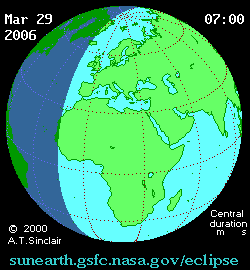This is an old revision of this page, as edited by OrphanBot (talk | contribs) at 08:32, 2 June 2006 (Removing image with no source information. Such images that are older than seven days may be deleted at any time.). The present address (URL) is a permanent link to this revision, which may differ significantly from the current revision.
Revision as of 08:32, 2 June 2006 by OrphanBot (talk | contribs) (Removing image with no source information. Such images that are older than seven days may be deleted at any time.)(diff) ← Previous revision | Latest revision (diff) | Newer revision → (diff)
The solar eclipse that took place on March 29, 2006 was a total eclipse of the Sun that was visible from a narrow corridor which traversed half the Earth. The magnitude, that is, the ratio between the apparent sizes of the Moon and that of the Sun, was 1.052. The path of totality of the Moon's shadow began at sunrise in Brazil and extended across the Atlantic to Africa, travelling across Ghana, Togo, Benin, Nigeria, Niger, Chad, Libya, and a small corner of Egypt, from there across the Mediterranean Sea to Greece (Kastellórizo) and Turkey, then across the Black Sea via Georgia, Russia, and Kazakhstan to Western Mongolia, where it ended at sunset. A partial eclipse was seen from the much broader path of the Moon's penumbra, including the northern two-thirds of Africa, the whole of Europe, and Central Asia.
Observations
People gathered in large areas where solar eclipse is visible around the World to view the event. Manchester Astronomical Society, the Malaysian Space Agency, the Astronomical Society of the Pacific, as well as dozens of tour groups met at the Apollo temple and the theater in Side, Turkey. The San Francisco Exploratorium featured a live webcast from the site, where thousands took their seats in the ancient, Roman-style theater.
Almost all actively visited areas in the path of totality had perfect weather. Many observers reported an unusually beautiful eclipse, with many or all effects visible, and a very nice corona despite proximity to solar minimum. The partial phase of the eclipse was also visible from the International Space Station, while the astronauts on board took spectacular pictures of the shadow on the Earth's surface. At first, it looked as though an orbit correction in the middle of March would bring the ISS in the path of totality, but this correction was postponed.

Notable times and coordinates
| Event | Time (UTC) | Coordinates |
|---|---|---|
| Beginning of the general eclipse | 07:36:50 | 14°27′42″S 22°06′24″W / 14.46167°S 22.10667°W / -14.46167; -22.10667 |
| Beginning of the total eclipse | 08:34:20 | 06°31′42″S 36°59′06″W / 6.52833°S 36.98500°W / -6.52833; -36.98500 |
| Beginning of the central eclipse | 08:35:25 | 06°18′18″S 37°15′48″W / 6.30500°S 37.26333°W / -6.30500; -37.26333 |
| Greatest eclipse | 10:11:20 | 23°08′54″N 16°45′36″E / 23.14833°N 16.76000°E / 23.14833; 16.76000 |
| End of the central eclipse | 11:46:55 | 51°33′42″N 98°48′12″E / 51.56167°N 98.80333°E / 51.56167; 98.80333 |
| End of the total eclipse | 11:47:55 | 51°20′36″N 98°30′30″E / 51.34333°N 98.50833°E / 51.34333; 98.50833 |
| End of the general eclipse | 12:45:35 | 43°26′18″N 83°03′00″E / 43.43833°N 83.05000°E / 43.43833; 83.05000 |
Type of the eclipse
| Nature of the eclipses | Total |
| Area of visibility | Type IV |
| Gamma | 0,3842 |
| Magnitude | 1.052 |
| Duration at greatest eclipse point | 247 s (4 min 7 s) at 10:11:18 UTC, near Chad border of Libya: 23°08′54″N 16°45′36″E / 23.14833°N 16.76000°E / 23.14833; 16.76000 |
| Maximum width of band | 183.5 km |
Gallery
-
 Sahara, Libya, 10:11 UTC
Sahara, Libya, 10:11 UTC
- Smolyan, Bulgaria, 10:30 UTC Smolyan, Bulgaria, 10:30 UTC
-
 Side, Turkey, 10:55 UTC
Side, Turkey, 10:55 UTC
-
 International Space Station, 10:56:55 UTC
International Space Station, 10:56:55 UTC
-
 Berkhamsted, England, 11:01 UTC
Berkhamsted, England, 11:01 UTC
-
 Novosibirsk, Russia, 11:42 UTC
Novosibirsk, Russia, 11:42 UTC
-
 Krasnoyarsk, Russia, 12:21 UTC
Krasnoyarsk, Russia, 12:21 UTC
-
 Kalmykia, Russia, 12:22 UTC
Kalmykia, Russia, 12:22 UTC
Satellite failure
Main article: Optus Fleet of Satellites § FailuresThe satellite responsible for SKY Network Television, a New Zealand pay TV company, failed the day after this eclipse at around 1900 local time. While SKY didn't directly attribute the failure to the eclipse, they said in a media release that it took longer to resolve the issue because of it, but this claim has been refuted by astronomers. The main reason for the failure was because of an aging and increasingly faulty satellite.
References
- Fred Espenak and Jay Anderson. "Total Solar Eclipse of 2006 March 29". NASA Technical publication (NASA/TP-2004-212762), November 2004.
- http://www.exploratorium.edu/eclipse/2006/index.html
- Stuff.co.nz, Astronomer refutes Sky TV eclipse explanation 31 March 2006.
- Press release by Sky TV. Solar eclipse interferes with satellite restoration Friday, 31 March 2006.
External links
Photos and videos
- Total eclipse photographs from Turkey
- Another set of total eclipse photographs from Turkey
- "People couldn't take their eyes off Sun" photo gallery from Turkey
- TV coverage of total eclipse in Turkey
- Phases of solar eclipse view from Antalya
- NASA videos and photos from Libya and Turkey
- Pictures taken from Smolyan, Bulgaria
- NASA video of eclipse
- Solar eclipse images and videos from Libya by traveling NASA employees and scientists
Other resources
- solar-eclipse-2006.info - Information about the March 29th Solar Eclipse.
- NASA - Total Solar Eclipse of 2006 March 29
- Interactive 2006 March 29 Total Solar Eclipse map with local circumstances
- eclipse.za.net - Umbral Paths of March 29 Eclipse in Africa
- University of Athens - Solar Eclipse 29/3/2006, Solar Party
- Solar Total Eclipse of 2006 March 39
- TÜBİTAK National Observatory - 29 March 2006 Total Solar Eclipse


